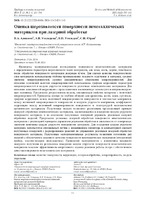Оценка шероховатости поверхности неметаллических материалов при лазерной обработке

Date
2024Publisher
Another Title
Assessment of Surface Roughness of Non-Metallic Materials during Laser Processing
Bibliographic entry
Оценка шероховатости поверхности неметаллических материалов при лазерной обработке = Assessment of Surface Roughness of Non-Metallic Materials during Laser Processing / В. А. Алексеев [и др.] // Приборы и методы измерений. – 2024. – Т. 15, № 2. – С. 131-141.
Abstract
Проведены экспериментальные исследования поверхности неметаллических материалов с определением параметров шероховатости таких материалов, как кожа, кость, дерево, пластмасса после обработки поверхности материалов лазерным лучом. Для оценки качества поверхностного слоя материалов использованы глубина проникновения лазерного излучения в материал, среднее значение микронеровностей, среднее квадратическое отклонение микронеровностей. Для описания изменений величин микронеровностей использованы графики корреляции параметров микронеровностей и модуля упругости поверхности различных неметаллических материалов. Для описания зависимостей корреляции с представлением в компьютере используются аппроксимирую- щие полиномы. Предложена регрессионная модель, связывающая свойства материала с величиной микронеровностей. Приведены данные по глубине абляции для древесины, кости, кожи, оргстекла, графики корреляции между величиной микронеровности поверхности и плотностью материалов, между величиной микронеровности поверхности и модулем упругости материалов, коэффициент корреляции между величиной микронеровности поверхности и температурой воспламенения органических материалов. Полученные модели позволяют реализовать предложенный принцип лазерной обработки неметаллических материалов, заключающийся в измерении модуля упругости поверхности материала и на основании полученных измерений управлять режимами лазерной обработки изделий. Предложена установка лазерной обработки поверхности неметаллических материалов с реализацией принципа управления режимами обработки в зависимости от измеренных значений величины модуля упругости поверхности материала. Для измерения модуля упругости материала используется специальный датчик с вдавливанием индентора и компьютерной оценкой полученных измерений с формированием решений по управлению режимами лазерной обработки поверхности материала. Полученные экспериментальные результаты позволили изготовить ряд изделий с обеспечением заданного качества поверхности неметаллических материалов (письменный прибор, изделие-подарок молодоженам). Проведение экспериментов с изменением мощности лазерного излучения по результатам измерения модуля упругости поверхности неметаллических материалов показало эффективность оперативного задания режимов работы лазера с обеспечением качества поверхности неметаллических материалов.
Abstract in another language
Experimental studies of the surface of non-metallic materials have been carried out to determine the roughness parameters of materials such as leather, bone, wood, plastic after processing the surface of materials with a laser beam. To assess the quality of the surface layer of materials, the depth of penetration of laser radiation into the material, the average value of the micro unevenness, and the mean square deviation of the micro unevenness were used. To describe the changes in the values of the micro unevenness, graphs of the correlation of the parameters of the micro unevenness and the modulus of elasticity of the surface of various non-metallic materials were used. Approximating polynomials are used to describe the correlations with the representation in a computer. A regression model is proposed that relates the properties of the material to the magnitude of the micro unevenness. Data on the depth of ablation for wood, bone, leather, plexiglass are presented, graphs of the correlation between the amount of surface micro unevenness and the density of materials, between the amount of surface micro-roughness and the modulus of elasticity of materials, the correlation coefficient between the amount of surface micro unevenness and the ignition temperature of organic materials. The obtained models make it possible to implement the proposed principle of laser processing of non-metallic materials, which consists in measuring the modulus of elasticity of the surface of the material and, based on the measurements obtained, control the modes of laser processing of products. The installation of laser surface treatment of non-metallic materials with the implementation of the principle of control of processing modes depending on the measured values of the modulus of elasticity of the surface of the material is proposed. To measure the elastic modulus of a material, a special sensor is used with indentation of the indenter and computer evaluation of the measurements obtained with the formation of solutions for controlling the modes of laser surface treatment of the material. The experimental results obtained made it possible to manufacture a number of products to ensure a given surface quality of non-metallic materials (a writing device, a gift for the newlyweds). Conducting experiments with changes in the power of laser radiation based on the results of measuring the modulus of elasticity of the surface of non-metallic materials has shown the effectiveness of operational setting of laser operating modes to ensure the quality of the surface of non-metallic materials.
View/
Collections
- Т. 15, № 2[7]
